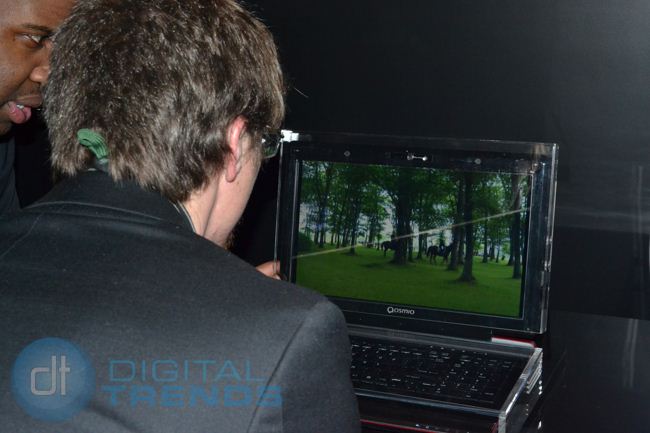
Following the anti-glasses backlash from involuntarily bespectacled 3D TV viewers everywhere, glasses-free TVs are riding the angst and taking CES 2011 by storm. While most companies at the show use the same parallax barrier technology, which spits out a number of fixed 3D “zones” around the TV, Toshiba has taken a different tack with its latest 3D laptop, which actually uses a webcam intelligently target the 3D effect on the fly. We lent our eyes to see how this seemingly novel concept works in the real world.
Toshiba had the demo set up on a Qosmio notebook, but the production version due out later this year could be on any Toshiba notebook (a Qosmio, though, is likely, according to our rep). As you approach the screen, the notebook’s tracking technology locks onto your eyes in a matter of seconds – even with glasses on. As they catch your eyes, the diverging images on the screen suddenly converge and form a 3D image, though a pretty poor one from a quality standpoint. Objects had a very watery, ethereal feel, and toward the edges of the screen, very thin objects like trees seemed to break apart and lose the cohesive 3D feel. This isn’t a final product, but there’s no question that it lacks the quality of displays that use active or passive glasses.

A demo screen on the notebook showed us a monochrome version of the webcam feed, with yellow boxes creepily overlaid on the eyes being tracked. While the software managed to plot them accurately, an obvious processing delay causes the boxes to visibly lag behind the face when you move around, and the 3D picture distorts accordingly. Even the smallest wag of your head throws causes the picture to momentarily lapse out of 3D while the system adjusts. It’s quick, but nowhere near the instant speeds it would need to create truly uninterrupted viewing.
What eye-tracking 3D lacks in quality and comfort (locking your head in front of the screen for a 30-minute show wouldn’t really fly), it makes up in convenience. The final production model should be able to flick it on and off at a moment’s notice, which could make it practical, at the very least, for viewing 3D photographs and movie trailers without digging out a pair of glasses. Still, the less-than-dazzling picture quality and delayed head tracking will need to be resolved before this technology grows legs that will carry it beyond early adopters.
Editors' Recommendations
- The 6 best desktop PCs for 3D rendering in 2024
- Save $100 on this compact, multi-purpose home 3D printer
- What is a 3D printer, and how much do they cost?
- Sony’s new 3D display tech keeps getting bigger and better
- Finally, you’ll soon be able to use 3D avatars on Teams calls


